


Unveiling The Enigmatic Connection

The concept of hypnosis has long been associated with the intriguing ability to unlock hidden memories. Whether for therapeutic purposes or in forensic investigations, hypnosis has been employed to access recollections that seem to be buried deep within the recesses of the mind. This connection between hypnosis and memory retrieval has generated both fascination and debate among scientists and the general public.
Hypnosis, a state of focused attention and heightened suggestibility, appears to provide a unique gateway to the subconscious mind. In this altered state of consciousness, individuals may be more receptive to suggestions and prompts from a skilled hypnotist, which can be harnessed to access and retrieve memories that are otherwise difficult to recall in a waking state.
One of the most compelling applications of hypnosis in memory retrieval is in the field of forensic psychology. Hypnotic regression, a technique used to guide individuals back to the time of an event they may have forgotten, has been employed to assist witnesses or victims in recalling critical details that can aid in criminal investigations. This technique has been instrumental in helping individuals remember faces, license plate numbers, or specific events that they might have forgotten or suppressed.
While the idea of uncovering hidden memories is undoubtedly intriguing, it's essential to approach the connection between hypnosis and memory retrieval with caution. Memories, especially those recovered under hypnosis, are not always accurate or reliable. Research has shown that suggestive questioning and leading prompts during a hypnotic session can inadvertently create false memories. The malleability of memory is a well-documented phenomenon, and the use of hypnosis can inadvertently implant false information.
In therapeutic settings, hypnosis can also be used for memory retrieval, especially in cases where repressed or traumatic memories are believed to be the root of a person's psychological distress. However, the use of hypnosis for memory retrieval in therapy is not without controversy. Some critics argue that it can lead to the creation of false memories, inadvertently causing harm to the individual seeking treatment.
Ethical considerations are paramount in the use of hypnosis for memory retrieval. Skilled and responsible hypnotists adhere to strict guidelines to ensure that suggestive techniques do not manipulate or distort the information retrieved during a session. This highlights the importance of working with licensed and reputable practitioners who prioritize the well-being of their clients.
The connection between hypnosis and memory retrieval remains a complex and enigmatic area of study. While hypnosis can provide access to seemingly forgotten memories, the reliability and accuracy of these recollections are subjects of ongoing debate and research. The power of suggestion and the potential for false memories are critical considerations when exploring the use of hypnosis for memory retrieval. Whether used in therapeutic contexts or criminal investigations, responsible and ethical practices are essential to ensure that the benefits of memory retrieval through hypnosis are realized without the risk of unintended consequences.
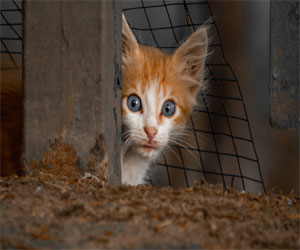 Territorial Aggression: Cats are territorial animals, and they may become aggressive when they perceive an intrusion into their space. This type of aggression is often triggered by other cats.
Territorial Aggression: Cats are territorial animals, and they may become aggressive when they perceive an intrusion into their space. This type of aggression is often triggered by other cats.
Play Aggression: Kittens and young cats frequently engage in play aggression, which involves pouncing, biting, and scratching. While it may seem playful, it can escalate if not managed properly.
Redirected Aggression: This occurs when a cat becomes agitated by a stimulus (e.g., another cat outside the window) and then redirects its aggression onto a nearby person or pet.
Pain-Related Aggression: Cats in pain may exhibit aggression as a defensive response. It's essential to rule out any underlying medical issues in cases of sudden aggression.
Understanding The Causes:
To address cat aggression effectively, it's essential to identify the root causes. Common contributing factors include:
Socialization issues during kittenhood.
Lack of mental and physical stimulation.
Sudden changes in the cat's environment.
Presence of other animals in the household.
Undiagnosed medical conditions causing pain or discomfort.
Fear or anxiety due to past traumatic experiences.

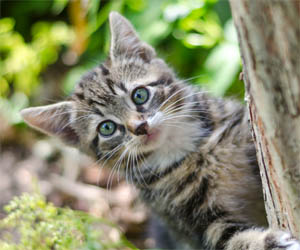




A Guide To Effective Dog Training
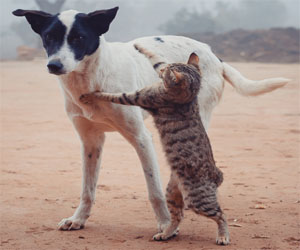 Positive Reinforcement
Positive Reinforcement
Positive reinforcement is one of the most effective methods for cultivating good behavior in your pup. This technique involves rewarding your dog when they exhibit desirable behavior. Treats, praise, toys, and affection are common rewards. When your pup associates good behavior with positive outcomes, they are more likely to repeat those actions.
Clicker Training
Clicker training is a precise and rewarding method for teaching dogs new behaviors. A small device, the clicker, emits a distinct sound that signals to your pup when they have performed the desired action correctly. This method enables clear communication and makes it easier for your pup to understand and learn commands.
Obedience Training
Obedience training focuses on teaching your pup essential commands like sit, stay, and come. These commands provide the groundwork for good behavior and ensure your pup's safety in various situations. Consistency and patience are key when practicing obedience training.
Crate Training
Crate training is an effective method for housebreaking your pup and providing them with a safe, comfortable space. Pups have a natural instinct to seek out enclosed spaces, and crate training takes advantage of this. The crate becomes a secure den for your pup and helps prevent accidents in the house.
Deciphering Cat Sleeping Patterns
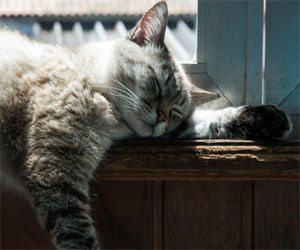 1. Cats Are Natural Sleepers: Cats are crepuscular animals, which means they are most active during dawn and dusk. Their natural hunting instincts dictate their active periods, and they typically sleep during the day and night. A cat's need for sleep is deeply ingrained in their biology, and they can sleep anywhere from 12 to 16 hours a day, depending on factors like age and activity level.
1. Cats Are Natural Sleepers: Cats are crepuscular animals, which means they are most active during dawn and dusk. Their natural hunting instincts dictate their active periods, and they typically sleep during the day and night. A cat's need for sleep is deeply ingrained in their biology, and they can sleep anywhere from 12 to 16 hours a day, depending on factors like age and activity level.
2. The Power Napper: Cat sleep is characterized by numerous short naps rather than one long, continuous sleep cycle. This style of sleeping is believed to be rooted in their wild ancestry, where they needed to remain vigilant to avoid predators or catch prey at a moment's notice.
3. Comfort Is Key: Cats seek comfort and safety in their choice of sleep locations. You may find your cat curling up in sunny spots to keep warm or seeking out secluded, high-up locations where they can rest undisturbed. Cardboard boxes, windowsills, and cozy nooks are all popular cat nap spots.
4. Cats Dream Too: Like humans, cats experience different stages of sleep, including REM (Rapid Eye Movement) sleep, during which they may dream. You might notice their paws twitching or their whiskers quivering during REM sleep, suggesting that they're actively dreaming.
5. Kittens Sleep More: Kittens and young cats require more sleep than their adult counterparts, with some kittens sleeping as much as 20 hours a day. This extended sleep period is essential for their rapid growth and development.
6. Factors Influencing Sleep: A cat's sleeping patterns can be influenced by several factors, including their health, age, environment, and routine.
 Recurring Dreams: Some individuals experience recurring dreams where the same themes, scenarios, or even specific characters reappear. These dreams may be a subconscious attempt to grapple with persistent issues, providing an opportunity for self-reflection and problem-solving.
Recurring Dreams: Some individuals experience recurring dreams where the same themes, scenarios, or even specific characters reappear. These dreams may be a subconscious attempt to grapple with persistent issues, providing an opportunity for self-reflection and problem-solving.
Premonitions: Some people claim to have dreamt of events before they occurred, a phenomenon known as precognitive dreaming. While the scientific validity of these claims remains a subject of debate, many believe these dreams to be glimpses of the future.
Sleep Paralysis: Sleep paralysis is a frightening phenomenon in which individuals wake up from a dream, unable to move, and may experience hallucinations or a sense of impending doom. It occurs as one transitions between sleep and wakefulness and is often linked to a disrupted sleep cycle.
Déjà Vu: Déjà vu is the feeling that a current experience has been previously encountered in a dream. This intriguing phenomenon has been the subject of much speculation and has sparked questions about the relationship between dreams and reality.
False Memories: Dreams have the power to create false memories. People may vividly recall events from their dreams as if they were real, blurring the lines between dream and waking life.
Out-Of-Body Experiences (OBEs): Some individuals report having dreams where they view their own bodies from an external perspective. These experiences can be both profound and disorienting, challenging our understanding of consciousness and self.
Epic Dreams: Epic dreams are those that seem to unfold over extended periods, sometimes covering the span of a lifetime within a single dream. These dreams can be rich with symbolism and often leave a lasting impact on the dreamer's waking life.
Telepathic Dreams: Some people claim to have dreamt of events or communicated with others telepathically during their dreams. The scientific explanation for such occurrences remains elusive, but they continue to intrigue and baffle researchers.
Nature's Enigmatic Canvas
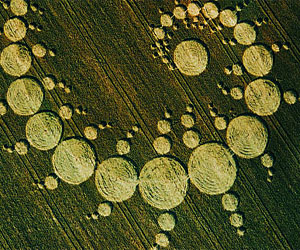 Geometric Precision
Geometric Precision
One of the most striking aspects of crop circle designs is the precision with which they are executed. The symmetry, mathematical ratios, and proportional accuracy found in many formations have left experts and enthusiasts alike in awe. The complexity of these patterns suggests a level of artistic and mathematical skill that challenges conventional explanations.
Symmetry And Symmetry Breaks
Symmetry is a common feature in crop circle patterns, with many formations exhibiting bilateral or radial symmetry. However, some crop circles also incorporate "symmetry breaks," where the pattern appears to intentionally deviate from perfect symmetry, introducing intriguing irregularities or asymmetrical elements.
Fractals And Self-Similarity
Fractal patterns are another fascinating component of crop circle designs. Fractals are complex shapes that exhibit self-similarity, meaning that they repeat similar patterns at different scales. These formations often evoke a sense of wonder, as the same design can be observed both in its overall shape and in its smaller components.